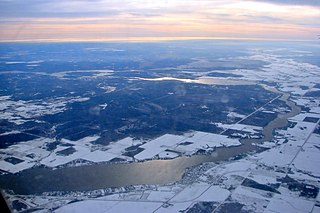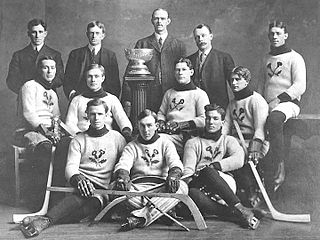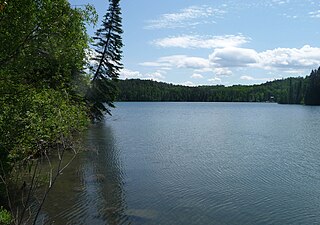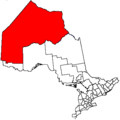
Kenora, previously named Rat Portage, is a small city situated on the Lake of the Woods in Ontario, Canada, close to the Manitoba boundary, and about 210 km (130 mi) east of Winnipeg by road. It is the seat of Kenora District.

Lake of the Woods is a lake occupying parts of the Canadian provinces Ontario and Manitoba along with the U.S. state of Minnesota. Lake of the Woods is over 70 miles (110 km) long and wide, containing more than 14,552 islands and 65,000 miles (105,000 km) of shoreline. It is fed by the Rainy River, Shoal Lake, Kakagi Lake and other smaller rivers. The lake drains into the Winnipeg River and then into Lake Winnipeg. Ultimately, its outflow goes north through the Nelson River to Hudson Bay.

The Winnipeg River is a Canadian river that flows roughly northwest from Lake of the Woods in the province of Ontario to Lake Winnipeg in Manitoba. This river is 235 kilometres (146 mi) long from the Norman Dam in Kenora to its mouth at Lake Winnipeg. Its watershed is 106,500 square kilometres (41,100 sq mi) in area, mainly in Canada. About 29,000 square kilometres (11,000 sq mi) of the watershed is in northern Minnesota, United States.

The Kenora Thistles, officially the Thistles Hockey Club, were a Canadian ice hockey team based in Kenora, Ontario. Founded in 1894, they were originally known as the Rat Portage Thistles. The team competed for the Stanley Cup, the ice hockey championship of Canada, five times between 1903 and 1907. The Thistles won the Cup in January 1907 and defended it once before losing it that March in a challenge series. Composed almost entirely of local players, the team comes from the least populated city to have won the Stanley Cup. Nine players—four of them homegrown—have been inducted into the Hockey Hall of Fame, and the Stanley Cup champion team was inducted into the Northwestern Ontario Sports Hall of Fame.
The Skatin First Nations, aka the Skatin Nations, are a band government of the In-SHUCK-ch Nation, a small group of the larger St'at'imc people who are also referred to as Lower Stl'atl'imx. The Town of Skatin - the St'at'imcets version of the Chinook Jargon Skookumchuck- is located 4 km south of T'sek Hot Spring- alt. spelling T'sek Hot Spring - commonly & formerly named both St. Agnes' Well & Skookumchuck Hot Springs The community is 28 km south of the outlet of Lillooet Lake on the east side of the Lillooet River. It is approximately 75 km south of the town of Pemberton and the large reserve of the Lil'wat branch of the St'at'imc at Mount Currie. Other bands nearby are Samahquam at Baptiste Smith IR on the west side of the Lillooet River at 30 km. and Xa'xtsa First Nations; the latter is located at Port Douglas, near the mouth of the Lillooet River where it enters the head of Harrison Lake. The N'Quatqua First Nation on Anderson Lake, between Mount Currie and Lillooet, was at one time involved in joint treaty negotiations with the In-SHUCK-ch but its members have voted to withdraw, though a tribal council including the In-SHUCK-ch bands and N'Quatqua remains, the Lower Stl'atl'imx Tribal Council.
Mishkeegogamang First Nation is an Ojibway band government in the Canadian province of Ontario. Until 1993, the band was called the Osnaburgh First Nation, with various settlements at times being called New Osnaburgh, Osnaburgh House, or Osnaburgh.

The Treaty Three Police Service (T3PS) in Ontario began as the Treaty #3 Policing Initiative in August 1999 as directed by the Executive Council of Grand Council of Treaty 3. It officially began operation on August 5, 2003, and became Canada's newest First Nation self-administered police service. Members of Treaty Three Police are appointed as First Nations Constables by the Commissioner of the OPP pursuant to s.54 of the Police Services Act. They have the powers of a police officer for the purpose of carrying out duties specified in their appointments and under federal law have the powers and protections of peace officers. Because First Nations Constables are not police officers as defined by the Police Services Act, their status in law is different but equal to that of a police officer. The jurisdiction of the Treaty Three Police Service includes all signatory Treaty Three First Nations previously policed by the OPP administered First Nations Policing Program. The OPP are mandated to provide policing on a reserve, village or any other area not currently under a policing agreement. All operations save major crimes are investigated by Treaty Three First Nations Constable patrol officers and/or the T3PS Crime Unit. The Service exists with the unanimous agreement of the signatory Band Councils or Band Chiefs. Unlike police forces in cities and towns, the Treaty Three Police Service is not required to provide all the regular services of a police force but does provide virtually everything needed.
The Long Plain First Nation is an Ojibway and Dakota First Nations band government whose reserve is located in the Central Plains Region of Manitoba, Canada. Its reserve lands include the Long Plain Reserve #6, the Keeshkeemaquah Reserve near Portage La Prairie, and the Madison Indian Reserve #1—the first urban reserve in Winnipeg.

William Durie Lyon was a merchant and political figure in Ontario, Canada.
Naotkamegwanning First Nation, formerly known as Whitefish Bay First Nation and known in the Ojibwe language as Ne-adikamegwaning, is an Ojibwe Nation from the Treaty Three Territory a 45min drive from Kenora, Ontario and is near Sioux Narrows, Ontario of Lake of the Woods.
Northwest Angle 33 First Nation is an Ojibwe or Ontario Anishinaabe First Nation band government who reside in Kenora District, Ontario near Sioux Narrows of Lake of the Woods.
The Lac La Ronge Indian Band is the largest Cree First Nation band government in La Ronge, Saskatchewan, and one of the 10 largest in Canada, with a 2016 population of 10,408. Its location is in north-central Saskatchewan. They are a Woodland Cree First Nation.
Wabaseemoong Independent Nations or more fully as the Wabaseemoong Independent Nations of One Man Lake, Swan Lake and Whitedog, is an Ojibway First Nation band government who reside 120 km northwest of Kenora, Ontario and 13 kilometres (8.1 mi) east of the Ontario-Manitoba border of northwestern Ontario, Canada. As of December 2018, the First Nation had a population of 2,000 registered people, of which their on-Reserve population was 1200 registered members and approximately 100 non-Band members.
Shoal Lake 40 First Nation is an Ojibway or Ontario First Nation reserve located in the Eastman Region of Manitoba and the Kenora District of Ontario. The total registered population in August 2021 was 667, of which the on-reserve population was 295. The First Nation is a member of the Bimose Tribal Council, a Regional Chief's Council that is a member of the Grand Council of Treaty 3.
Niisaachewan Anishinaabe Nation, formerly but still commonly—and incorrectly—known as the Dalles First Nation and Ochiichagwe'Babigo'Ining Ojibway Nation, is an Ojibway or Ontario Saulteaux First Nation band government in Kenora District, Ontario near Sioux Narrows of Lake of the Woods.
Sandy Bay First Nation is an Ojibway/mixed-blood First Nation in Manitoba, Canada. As of the 2016 Canadian Census, it had a population of 2,515; while the First Nation's website reported a membership of 6,776 individuals as of April 2018.
The Ekwan River is a river in Kenora District in northwestern Ontario, Canada. It appears as Equam on Bellin map of 1744. Ekwan River is of Cree origin, meaning "the river far up the coast". It travels about 500 kilometres (311 mi) from its source at Zumar Lake on the Canadian Shield, through the Hudson Bay Lowlands, northeast and then east, to its mouth on James Bay.

Kakagi Lake, also known as Crow Lake, is a lake in both Unorganized Kenora District and the township of Sioux Narrows-Nestor Falls, Kenora District, in Northwestern Ontario, Canada. It is just north of the community of Nestor Falls, and right across Ontario Highway 71 from Stevens Bay on Lake of the Woods. It also feeds Lake of the Woods through a series of lakes starting with Cedartree Lake.
Ojibways of Onigaming First Nation is an Ojibwe or Ontario Saulteaux First Nation located in Kenora District, Ontario near Nestor Falls, Ontario. Together with the Big Grassy First Nation, Ojibways of Onigaming First Nation is a successor apparent to the former Assabaska Band of Saulteaux. Total registered population in February, 2012, was 737, of which the on-reserve population was 445. The First Nation is a member of the Anishinabeg of Kabapikotawangag Resource Council, a regional tribal council that is a member of the Grand Council of Treaty 3.
Rat Portage 38B is a First Nations reserve on Lake of the Woods in Kenora District, Ontario. It is one of the reserves of the Anishinabe of Wauzhushk Onigum.







